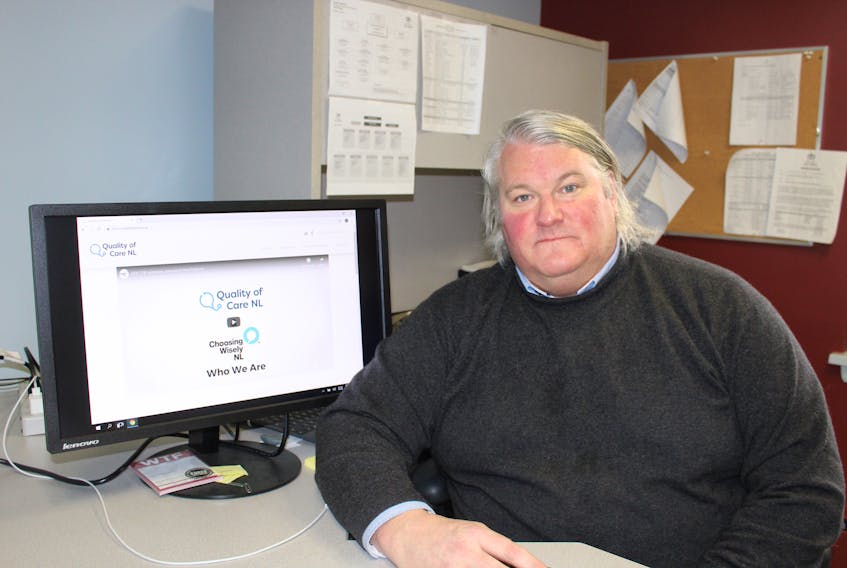ST. JOHN'S, N.L. — Developing the proper protocol and acting FAST can help stroke sufferers survive.
Dr. Gregory Browne, a vascular specialist and surgeon, is part of the team with Quality of Care NL/Choosing Wisely NL that is conducting extensive research into how to make this happen. He has seen the results.
When someone suffers a stroke, it’s hoped the public awareness campaign’s FAST method will swing into action that starts with noticing someone’s face is drooping. Ask them to raise both of their arms, listen to see if their speech is slurred and if any of these things are present, call 911 right away.
“We have visited each of the health associations in the province to see what needs to be done to improve outcomes,’’ Browne said recently.
As an example, he said, Clarenville is the best-performing hospital in the province.
“They did their own thing, even before we started and have made 25-30 per cent improvements over the past three years.”
He credited Dr. Etienne van der Linde with piloting the project, building the team in Clarenville and leading them to the improvements.
“We have seen the benefits of the work, but there is still lots of work to be done." — Dr. Gregory Browne
“If they can do it, then it is doable anywhere in Newfoundland and Labrador. We just need to establish the same protocols and get them introduced into the system, facilities and personnel,” Browne said.
“We have seen the benefits of the work, but there is still lots of work to be done,’’ he added.
Browne said most provinces expect to have about 800 stroke patients each year, but there are 1,200-1,400 strokes annually in Newfoundland and Labrador. It’s the third highest cause of death in Canada.
“We have the highest incidence and the poorest outcomes,’’ Browne said.
He said strokes can be prevented if patients learn to recognize the signs and get to a hospital immediately for treatment.
With his partners at Quality of Care NL/Choosing Wisely NL, Browne released a video to remind viewers of the warning signs of stroke and the importance of treatment within 4 1/2 hours.
“If you recognize that you’re having a stroke, you need to get to an emergency room as fast as possible,” Browne said.
“One shot of a drug called Alteplase can stop or even reverse the harmful effects of a stroke, but it has to be given within 4 1/2 hours from the start of a stroke.”
Alteplase is a tissue plasminogen activator; it works by breaking down the blood clots that cause some kinds of strokes and heart attacks.
Browne said stroke patients in this province are treated at lower rates than those elsewhere. Only 10 per cent of patients here receive a shot of Alteplase in time for it to be effective. The national target for treatment is closer to 25 per cent.
But to get to the point where the drugs can be administered, a number of things have to happen.
“In order to get (the shot) the patient has to undergo a CT scan to make sure they don’t have a bleeding type of stroke,’’ Browne said.
“If you give the clot-busting drug to someone with a brain bleed, you will make the situation worse.”
Time is critical, he said. Statistics show that every minute that passes following a stroke, the patient loses 1.9 million brain cells.
He said if the correct protocols are in place, the patient gets to a facility quickly and the appropriate assessments and tests are conducted, there is a greater chance of survival and even full recovery.
Women are disproportionately affected — 45 per cent more women die from a stroke than men in Canada, and because they live longer, more women are living with the effects of stroke.
Quality of Care NL/Choosing Wisely NL is a program to help improve the quality of care patients receive by ensuring that the right treatments get to the right patients at the right time.
It is an educational initiative seeking to match a patient’s medical needs with the most appropriate and safest type of care. For each initiative and outreach program, Quality of Care NL/Choosing Wisely NL has identified key areas of risk and will work towards improving, through the supply of educational resources, the appropriate use of testing and treatment in these areas.
The program officially launched in October 2016.
More information can be found on the Quality of Care NL/Choosing Wisely NL website.
FAST facts
- The most common type of stroke is Ischemic stroke, caused by a blood clot that breaks off and goes to the brain, occurs in 85 per cent of all stroke patients.
- A hemorrhagic stroke occurs in the remaining 15 per cent, when a blood vessel ruptures, causing bleeding in the brain.
- A transient ischemic attack (TIA) — sometimes referred to as a mini-stroke — is caused by a small clot that briefly blocks an artery.
- More than 62,000 strokes occur in Canada each year and that number continues to rise, leaving more than 405,000 people in Canada living with the effects of stroke.









